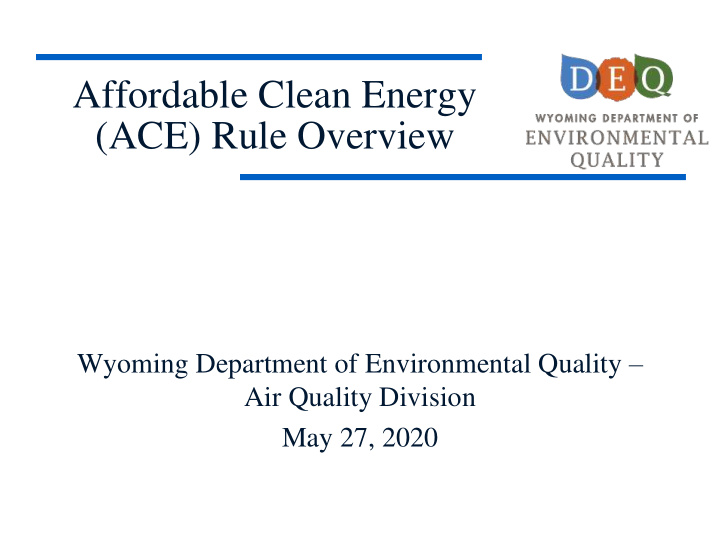



Affordable Clean Energy (ACE) Rule Overview Wyoming Department of Environmental Quality – Air Quality Division May 27, 2020
ACE Rule Overview The ACE Rule replaces the Clean Power Plan (CPP): The CPP was promulgated in October 2015 and was stayed by the U.S. Supreme Court in February 2016 The ACE Rule was promulgated on July 8, 2019 and became effective on September 8, 2019 The ACE Rule sets Emissions Guidelines for states to develop and submit state plans 2
ACE Rule Overview • Basic overview of state plans: • State plans will set Standards of Performance for CO 2 emissions from existing coal-fired electric generating units (EGUs) • Emphasis upon state-specific, unit-specific standards that consider varying operating conditions at each unit • Revises implementation guidelines for Clean Air Act Section 111(d) 3
Key Components of ACE Rule • Focus is on power plant efficiency-based guidelines • Standards are developed through rate-based (lb/MWh) • Standards are unit-specific • Compliance requirements are unit-specific and provide certain flexibilities • Consider variabilities in operating conditions 4
Key Components of ACE Rule • States submit plan by July 8, 2022 (three years from promulgation of ACE Rule) • Plan considers: • Unit-specific evaluations of candidate Best System of Emission Reduction (BSER) Heat Rate Improvement (HRI) technologies and practices • Monitoring, recordkeeping and reporting requirements • Future operating condition projections through 2035 5
BSER HRI Technologies • Candidate technologies for BSER HRI that achieve emission reductions through efficiency gains: • Neural Network/Intelligent Sootblowers • Boiler Feed Pumps • Air Heater and Duct Leakage Control • Variable Frequency Drives • Blade Path Upgrades for Steam Turbines • Redesign or Replacement of Economizer • Improved Operation and Maintenance (O&M) Practices 6
Standards of Performance • There are five steps for establishing Standards of Performance under the ACE Rule: • Establish baseline heat and emission rates • BSER HRI technologies • Evaluation of degradation rates for BSER HRI technologies • Evaluate “other factors” • Develop a final Standard of Performance 7
Federally Enforceable Plan Requirements • Requirements for federally enforceable plan: • Identification of Designated Facilities • Setting Standards of Performance • Identification of unit-specific recordkeeping, reporting and monitoring requirements • State reporting to EPA 8
Clean Air Act Section 111(d) • Clean Air Act Section 111(d): • Establishes standards for existing sources that are not regulated by National Ambient Air Quality Standards (NAAQS) or Clean Air Act Section 112. • CO 2 is one of these pollutants • NAAQS pollutants (do not apply to this rule): O 3 , PM 2.5 /PM 10 , NO x , SO 2 , CO, Pb 9
Revisions to CAA Section 111(d) • Revises: • EPA’s role in providing information for states to develop state plans • Timing considerations for state plan submissions • Timing considerations for EPA actions on state plans • Timing considerations for EPA actions on federal plans • Changes to specific definitions to provide certainty and clarity of intent • Changes to completeness criteria for state plans • Establishes process for determining completeness of a state plan submission 10
Path Forward for ACE Rule • WDEQ-AQD must receive data from EGU operators on each unit: • Necessary for measuring and setting baseline and future heat and emission rates • Necessary for choosing whether to calculate through net vs. gross heat rate • Demonstrates variability of operating conditions, load demand, etc. • WDEQ-AQD must receive public input on performance standards and rule implementation 11
Options for Implementation • Option #1: State Plan • Adoption of plan into Wyoming Air Quality Standards and Regulations (WAQSR) • Would have to go through statutory rulemaking process to become state-effective rule • Would have to go through state plan approval process • Would have to undergo EPA review and approval process • Potential timeframe for approval: 18-20 months 12
Options for Implementation • Option #2: Permit/Order/Consent Decree and Plan • Develop and issue unit-specific, federally enforceable permits • Permits set performance standards for each unit • Permits would undergo required public notice and legal review • Permits would be adopted into state plan • Would have to undergo EPA review and approval process • Potential timeframe for approval: 12-14 months 13
Options for Implementation • Option #3: Federal Plan • EPA develops federally enforceable plan for existing coal-fired EGUs in Wyoming • AQD, facilities would undertake early engagement with EPA • Plan would undergo federal public comment and approval process • EPA would maintain primacy over plan • Potential timeframe for approval: Uncertain 14
Options for Implementation • Option #4: Other Options • We are interested to hear and consider any other ideas or possibilities for rule implementation that you may have. • We will open the floor for discussion during the public input session following questions about this presentation. 15
ACE Rule Resources • Wyoming DEQ Website: ACE Rule • You can access the DEQ-AQD ACE Rule webpage at: deq.wyoming.gov/aqd/resources/ace-rule/ • Users can access a number of different ACE Rule resources including: this PowerPoint presentation, EPA ACE Rule fact sheets, various implementation guidance documents, etc. • This webpage will be updated with more information as the implementation process moves forward 16
Providing Written Comment • The AQD will accept written input through June 10; input must be submitted in one of the following manners: • Electronically by filling out the electronic comment form at http://aq.wyomingdeq.commentinput.com/ • Via mail addressed to Nancy Vehr, Administrator, DEQ/AQD, 200 West 17th Street, Cheyenne, Wyoming, 82002, or faxed to 307-365-1784 17
Questions? • Please feel free to ask any questions at this time about this presentation or other aspects of the ACE Rule 18
Recommend
More recommend